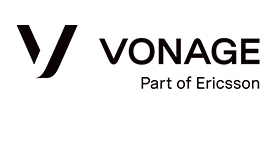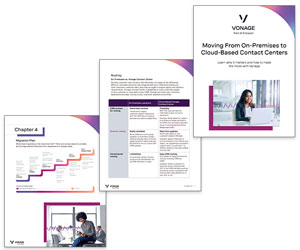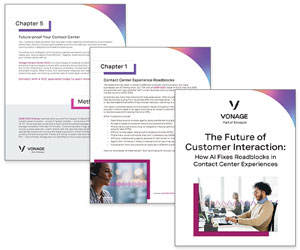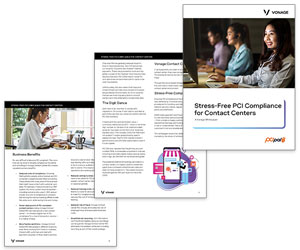Vonage teaches you everything you need to know about contact centres, putting you in the best position to choose the right contact centre solution for your business.
A good contact centre provides an excellent foundation for building any customer-facing business. In today’s digital-first world, customers need to be able to contact you in the way that best suits them and for you to provide them with a first-class experience on whichever channel they choose.
What is a Contact Centre?
The meaning of contact centre is a specialized hub designed to provide customer service across multiple communication channels.
The channels handled by a contact centre can include phone, email, live chat, SMS, video chat, and social media, basically, any customer interaction will come through a company’s contact centre.
Agents manning these centres may be specialized in one channel in particular, but many will be multi-skilled and capable of switching between channels based on demand.
A contact center aims to provide fast, reliable, and personalized customer service to everyone interacting with the brand. This could be through answering customer service queries in an inbound contact center or providing a first-rate sales experience in an outbound contact center.
Either way, customer satisfaction is a key concern. Contact centers will often closely measure metrics like average handling time, call wait time, abandonment rate, and first-call resolution to ensure their agents give customers the best possible experience, encouraging them to continue doing business with the brand.
To achieve their targets for these metrics, many contact centre managers will turn to specialized software to help their agents provide effective and efficient customer service.
The best contract centre platforms provide a centralized hub where agents can interact with customers across multiple channels while enabling access to helpful features such as live call transcription or artificial intelligence (AI)-powered live chat.
Businesses will often use other tools with their dedicated customer contact centre software. One example would be customer relationship management (CRM) platforms, which can store valuable customer details, including past interactions, to help reduce agents’ workloads and speed up interaction times.
Contact Centre vs. Call Centre
As customer needs evolve, many businesses are turning away from more traditional call centres in favour of modern contact centres. But what exactly are the key differences when it comes to contact centre vs. call centre?
Scope of Communication
- Call centre – Call centres’ primary focus is voice calls, managing inbound and outbound telephone interactions.
- Contact centre – Contact centres also handle inbound and outbound voice calls alongside other interaction methods such as SMS, live chat, email, messaging, social media, and video conferencing. Importantly, the role of AI in contact centres is rapidly expanding, helping automate routine tasks, enhance customer experiences, and improve efficiency. With AI-driven solutions like chatbots, predictive analytics, and sentiment analysis, contact centres can streamline operations, reduce response times, and provide personalized service at scale.
Technology
- Call centre – Many call centres use basic telephony infrastructure. On-premises call centre facilities allow for basic call management features such as call waiting and routing.
- Contact centre – Contact centres often employ more advanced technology, allowing for a greater range of features to be used. Multichannel routing, live transcription, call recording, real-time coaching and assistance for agents, and visual voicemail are some of the advanced features that contract centres can access.
Many contact centre systems are hosted in the cloud, meaning businesses can forgo installing and maintaining a lot of on-premises equipment.
Customer Experience
- Call centre – Interactions are usually based solely on voice communication and are often less personalized and more transactional. The focus is on solving problems quickly to achieve greater call efficiency.
- Contact centre – Customers have a greater choice of channels to reach out through, allowing them to choose one that suits their needs best. The customer experience is often prioritized, with features employed to improve personalization and customer satisfaction.
Workforce
- Call centre – Agents are often required to possess a specific skill set focused on phone communication.
- Contact centre – Agents must be versatile and possess skills in various interactions and technologies. Agents may be required to monitor different channels based on demand or switch between multiple channels when dealing with a single customer.
Types of Contact Centres
Contact centres can vary greatly depending on the business’s needs, meaning no two contact centres are ever exactly the same.
There are a few broad terms that can be used to categorize contact centres, however, that we’re going to take a look at now. It’s worth noting that these terms aren’t always mutually exclusive, and contact centres can fall under one, two, or more of these definitions.
Inbound Contact Centre
An inbound contact centre primarily handles incoming communications initiated by customers. These could be questions about customer accounts, queries about services such as shipping or payment, or support requests for products or services.
Multichannel support is a key feature of inbound contact centres, allowing customers to reach out through the channel that suits them best. Contact centre agents often have vast knowledge bases, enabling them to provide detailed and reliable support.
While inbound contact centres usually offer support, they can contribute to sales, for example, by dealing with customer agreement renewals.
Inbound contact centres must be able to provide great customer service to boost customer satisfaction and secure high levels of customer retention.
Outbound Contact Centre
Outbound contact centres exist to drive business-generated communications with customers and potential customers.
They’ll focus on tasks such as lead generation, telemarketing, gathering customer feedback, and market research. They can also support less revenue-generating pursuits, such as product recalls.
Because outbound contact is very time-sensitive, these contact centers focus on communication channels that provide a high degree of immediacy, such as phone calls and SMS messages.
Outbound contact centres will often use features such as auto-diallers to help streamline the process of contacting a multitude of customers in a short time.
In small and medium-sized businesses, outbound contact centre agents may effectively take on the role of salespersons. Larger businesses and enterprises often support dedicated sales teams by generating leads and setting up sales appointments.
Blended/Hybrid Contact Centre
A blended or hybrid contact centre combines elements of both inbound and outbound contact centres. Often, agents working in hybrid contact centres will have experience contacting leads in a sales capacity and also handling incoming customer support queries.
Because both inbound and outbound communications are directed through a single facility, blended contact centres can greatly improve the customer experience.
Access to a greater range of customer data and history of interactions means that agents can provide more comprehensive support and a more personalized experience. In contrast, streamlining business workflows means that a smoother, more efficient experience is provided.
However, while there are benefits to combining inbound and outbound contact centers, there can also be drawbacks. For example, managers will often have to track the performance of a larger number of agents and will have a greater range of metrics to monitor and maintain.
Omnichannel Contact Centre
By their very nature, all contact centres are, at the very least, multichannel, as they focus on more communication channels than just telephone calls. An omnichannel contact centre, however, takes things a step further.
While multichannel and omnichannel contact centers provide multiple ways for customers to interact with a business, an omnichannel contact center emphasizes integrating the different channels to provide a cohesive and seamless customer experience.
Multichannel communication centers will manage different communication channels separately, often with different teams working independently for different channels. However, every channel is brought together into a unified system in an omnichannel contact center.
This gives agents a complete view of a customer’s interaction history, allowing them to provide more consistent, more relevant support.
This is important to customers: Salesforce’s State of the Connected Customer Report 2023 acknowledges that 79% of customers expect consistent interactions across departments.
Moreover, agents in an omnichannel contact center can switch effortlessly between communication channels, enabling them to better respond to their customers’ needs and meet them where they are.
On-Premises Contact Centre
Businesses operating an on-premises contact centre will physically host and manage their hardware, software, and infrastructure rather than hosting it in the cloud by a third party.
This means the company owns its equipment and manages its servers, giving it total control over its infrastructure.
It also means they do not have to trust another company to process and store their data properly; they have total control over its use and security.
Obtaining the equipment necessary to run an on-premises contact center often requires a large initial investment, especially compared to the cloud-based alternative. There are also ongoing maintenance and staffing costs to consider.
Hosted, Virtual, or Cloud-Based Contact Centre
Choosing a hosted contact centre means that a third-party provider manages the infrastructure. This might be in the cloud or on their own servers. This offers greater flexibility and scalability and greatly reduces IT costs for a business.
As with most cloud services, businesses can choose which services they require for their contact center, allowing them to build a service that offers all the features they need without the cost of paying for ones they don’t. This greater flexibility means businesses can develop an inbound, outbound, or hybrid contact center as required.
Agents can access a cloud-based contact centre regardless of their physical location. This makes them a perfect solution for businesses that wish to further reduce costs by employing remote workers and distributed teams.
Contact Centre Services and Use Cases
Contact centres can be employed in various ways, depending on the business’s needs.
Customer Support
Contact centres are essential in any customer support efforts. They provide a centralized hub where businesses can interact with their customers, answer their questions, resolve their issues, and enhance their overall experience.
Contact center agents can provide customers with information about products, services, policies, account details, etc. Existing customers can have any complaints addressed and issues resolved with the help of a contact center, helping to reduce their frustration and hopefully secure their ongoing custom.
Contact center agents can assist with troubleshooting, installation guidance, and usage tips for tech-related products or services, often with escalation paths to specialized tech teams if needed.
Using customer data, contact center agents can tailor interactions based on customer preferences and interaction history, allowing them to provide more relevant solutions and recommendations.
A contact centre business can even help customers find their solutions to problems. Interactive Voice Response (IVR) systems and virtual assistants can handle common queries and facilitate self-service support.
They can direct customers to the right department for more difficult tasks, reducing wait times and freeing agents for more complex tasks.
Contact centres are often responsible for developing and maintaining online resources, like FAQs and guides, which empower customers to find solutions independently.
Sales and Lead Generation
Contact centres can also help maximize sales opportunities, enabling businesses to connect with prospects, upsell existing customers, and follow up on leads.
Agents can contact prospects directly via phone or other channels to introduce products and services. Cold calling in this way is often used to create brand awareness and generate interest and can be carried out in a structured and organized manner from an outbound contact center.
Contact center agents can then assess the prospect’s needs, budget, and buying intent, determining if they fit the company’s offerings well. This qualifies leads and saves the sales team time by focusing only on high-potential prospects.
Once leads have been qualified, contact center teams can follow up with and nurture them as required. Contact centers can also act as scheduling hubs. Agents can set up appointments or demos for prospects based on the availability of sales teams.
Contact centres allow agents to maintain ongoing, value-generating relationships with existing customers.
Once a lead is converted to a paying customer, the contact centre can continue identifying opportunities to offer complementary products or upgraded services.
Based on customer purchase history and preferences, agents can suggest relevant products or services, increasing the average customer lifetime value and boosting sales without high acquisition costs.
Market Research
Contact centres are valuable tools when it comes to market research. They provide a direct line to customers and prospects, enabling companies to gather insights, gauge customer sentiment, test new ideas, and understand market trends.
After a customer purchases, contact centres can conduct follow-up surveys to gauge customer satisfaction (CSAT) and Net Promoter Score (NPS).
These metrics help businesses understand how customers feel about their experience with the brand and how it could be improved for greater success in the future.
For customers who have chosen to leave or cancel a service, agents can gather insights into reasons for churn, allowing the company to address pain points and improve retention.
Surveys can be used to understand customers’ preferences regarding product features, price points, packaging, or communication methods. This information can refine future designs and make products as attractive as possible.
During interactions, agents can collect demographic information such as the age, gender, and location of customers, as well as psychographic data such as their interests and lifestyles. This can help the business to create more accurate customer personas for targeted marketing.
A contact center service can also determine brand perception and awareness, helping businesses assess how well their brand aligns with customer expectations and values.
Alongside this, agents may also capture information about competitors’ offerings. If a customer mentions using competing products, contact centre agents can gather details about why customers prefer them, helping the business understand competitors’ advantages and potential areas for improvement.
Contact Centre Benefits: Why You May Choose One Over a Call Centre
If you’re looking for a way to offer high-quality, multichannel engagement to your customers, then a contact centre is certainly the way forward. Here are just a few of the key advantages that contact centres provide over more traditional call centres.
Better Customer Experience (CX)
According to Salesforce’s State of the Connected Customer Report 2023, 80% of customers say the company’s experience is just as important as its products and services.
Contact centres provide a more flexible, efficient, and integrated approach to customer service than traditional call centres, allowing them to provide a much better customer experience.
Customers can reach out via the channel that suits them best with minimum effort. If they’re out and about often, they can contact via SMS and reply using their mobile device when it suits them.
If they’ll be stuck in front of their computer all day at work, they can send an email so they don’t have to check their phone constantly. Not to mention that customers who prefer to do things the old-fashioned way can still get in touch over the phone.
Contact centre integrations with CRM software allow agents to provide customers with a more personalized, efficient, and effective service.
This increases the chances that problems will be solved during the first interaction, which positively affects customer experience.
Contact centers make it possible to provide round-the-clock customer service, too. By employing remote teams to work in cloud-based contact centers, businesses can ensure customers can access support whenever needed, whatever time zone they’re in.
Enhanced Efficiency and Productivity
The advanced features available on contact centre platforms allow businesses to streamline their workflows, allowing their agents to handle interactions more effectively and quickly.
Intelligent routing is one such feature. This enables customers to answer automated questions upon reaching the contact center, ensuring they’re connected to the department or agent best positioned to deal with their query.
This reduces average handling time and improves the first-call resolution rate. Solving queries faster means that agents can deal with more daily communications, thereby improving customer waiting times and ensuring that more customers solve their problems promptly.
Cost Savings
Cloud-based contact centres dramatically reduce the need for on-site infrastructure. This helps businesses reduce the costs of obtaining, installing, and maintaining traditional contact centre hardware.
It also means they can scale their service as necessary. Businesses only need to pay for the number of lines and communication channels they require, meaning they don’t have to spend a small fortune on a load of services they’ll never use.
The ability to employ remote teams also opens up cost-saving opportunities. Rather than renting office space and buying equipment, contact center agents can work from home using their own devices while still having access to all the features they need to provide an excellent customer experience.
Deeper Insights Into Customer Journeys
By integrating with other platforms, a contact centre system can provide businesses with a wealth of information about their customers and journeys.
Analyzing inbound customer support contact center data can highlight recurring pain points and frequently asked questions.
Businesses can then produce guides and knowledge bases that tackle these issues, helping customers access self-service support and reducing unnecessary pressure on contact centres.
Customer preferences and consumer trends can also be identified. These insights can then be used to refine development and marketing initiatives going forward, ensuring that the business speaks to its customers most effectively.
The more insights a business can gather about its customers, the more it can personalize its interactions with them.
Not only does this make customers feel more valued, it also maximizes the chance of successful interactions, boosting customer satisfaction and customer retention.
70% of consumers in the U.S. say a personalized experience, in which a company knows who they are and their history with the brand, is important, according to figures published in Shep Hyken’s 2024 State of Customer Service and CX Study.
How is AI Used in a Contact Centre?
AI transforms today’s contact centres by streamlining manual or tedious tasks, taking the client experience to a new level, and generally boosting organization. Let’s look at some of the use cases of AI in a contact centre.
Chatbots and Virtual Assistants
AI-powered bots handle routine customer queries, providing instant responses and 24/7 support. This reduces wait times and allows agents to focus on more-complex issues.
AI analyses customer data to predict issues, behaviours, or product preferences. It helps agents anticipate customer needs, provide personalised recommendations, and deliver a more tailored experience. AI can also forecast call volumes, helping contact centres optimize staffing and improve service levels.
Analysis
AI analyses customer interactions in real-time to detect sentiment, whether a customer is happy, frustrated, or neutral. This allows agents to adjust their approach or escalate issues when necessary, improving customer satisfaction.
Speech-to-text and voice recognition: AI in speech-to-text and voice recognition tools helps transcribe calls, search for keywords, and improve call routing.
This enhances accuracy, streamlines documentation, and ensures customers are directed to the appropriate agent or department.
Omnichannel Communication
AI enables contact centres to manage multiple communication channels (chat, voice, email, social media) seamlessly.
By providing consistent support across these platforms, customers receive a unified experience, improving overall satisfaction.
Agent Performance Analysis
AI analyses agent performance by tracking metrics like resolution time and customer feedback. It offers real-time suggestions or coaching for agents to improve, making training more efficient and personalized.
Contact Centre Features: The Tech and Functionality You Need From Contact Centre Software
Contact centre software platforms offer many features in all shapes and sizes. We’re going to go over some of the most vital features here so you know that the platform you choose has everything you need to help you offer a fantastic experience for your customers and agents.
Interactive Voice Response (IVR)
Interactive Voice Response (IVR) allows you to automate your customer’s initial interactions with your contact centre.
For example, a customer may call your helpline number for assistance with their billing account. Straight away, their call is answered by intelligent IVR.
The customer is presented with a selection of predetermined options, e.g., inviting them to press 1 for technical assistance, 2 for shipping inquiries, 3 for billing queries, etc.
In this way, the customer is automatically routed to the correct department. Not only does this reduce their waiting times and improve customer satisfaction, but it also reduces the workload for your agents, giving them more time to dedicate to value-adding tasks.
Intelligent Call Routing
Intelligent call routing is a similar feature to IVR, but it takes things a step further. In addition to ensuring that customers are directed to the right department, intelligent call routing can ensure they’re put through to the best individual agent to help them.
This could mean simply directing the call to the next available agent to reduce waiting times, but it could also mean directing a call to the agent with the best knowledge to solve the query based on their past performance, or an agent who speaks the same language as the caller.
Directing calls with this level of attention can help greatly improve first-call resolution rates.
Call Monitoring Capabilities
Call monitoring allows managers to listen in to live calls. This can be invaluable when helping to train new hires, allowing managers to share guidance and next steps without sacrificing the customer experience.
Any agent can receive assistance should it be needed, whether they’re dealing with a difficult call or simply require some additional coaching. Call monitoring is an excellent feature that helps maintain call quality and ensure customer satisfaction.
Outbound Diallers
An outbound dialler streamlines the process of making outbound calls. Phone numbers are dialed in sequence from a pre-set list. If a call is answered, it’s connected to an agent to begin the sales pitch or market research.
This saves agents from wasting time sitting online waiting for a customer who will never pick up. They can improve efficiency, reduce downtime, and minimize dropped calls.
Analytics and Reporting
The ability to track performance metrics and gain insights from data is an invaluable feature in contact centre software.
Whatever the metrics you’re targeting, contact centre software can help your managers explore performance at a granular level, producing reports that can be fed back to other organizational stakeholders.
Agent productivity statistics such as average handling time, first-call resolution rate, call abandonment rate, and after-call work time can all be monitored, giving managers insight into how agents perform and what coaching they may benefit from.
Customer satisfaction statistics such as CSAT scores and net promoter scores can also be tracked to see how your customers are responding to the contact center experience and where potential areas for improvement may lie.
Integration With Your CRM
Integration between your contact centre software and customer relationship management (CRM) platform allows your agents access to valuable customer data.
Interaction histories can provide insights into what issues a customer may have faced, what kind of troubleshooting has already been attempted, and what the resolution was.
Access to this information also allows agents to personalize customer service better, providing an individual experience tailored directly to an individual customer’s needs and helping them feel valued and appreciated.
Considerations When Implementing a Contact Centre
Establishing a contact centre can benefit your business, but it’s no small undertaking. Here’s our list of some of the key considerations you should pay attention to when implementing your contact centre.
Unique Business Needs
Consider what features and functions most closely align with your needs. Do you need an inbound, outbound, or blended contact centre? Is it beneficial to have multilingual agents in different time zones?
Necessary Communication Channels
Who’s your target audience, and which communication channels do they use most? Are they young and tech-savvy, and will they want to message you on social media? Are they more traditional, and will they want to contact you over the phone?
Key Performance Indicators (KPIs)
How will you measure the success of your contact centre? What are the benchmark scores in these metrics across your industry?
Budget
Consider contact centre pricing. Can you afford the initial investment for an on-premises solution? Is the flexibility and scalability of a cloud-based solution more cost-effective?
Scalability
Are you planning for growth in your business? (Of course, you are!) Think about a cloud-based solution that can expand quickly alongside your customer base.
This blog post has been re-published by kind permission of Vonage – View the Original Article
For more information about Vonage - visit the Vonage Website
Call Centre Helper is not responsible for the content of these guest blog posts. The opinions expressed in this article are those of the author, and do not necessarily reflect those of Call Centre Helper.
Author: Vonage
Reviewed by: Rachael Trickey
Published On: 1st Sep 2025
Read more about - Guest Blogs, Vonage






 Vonage is redefining business communications, helping enterprises use fully-integrated unified communications, contact centre and programmable communications solutions via APIs.
Vonage is redefining business communications, helping enterprises use fully-integrated unified communications, contact centre and programmable communications solutions via APIs. 












